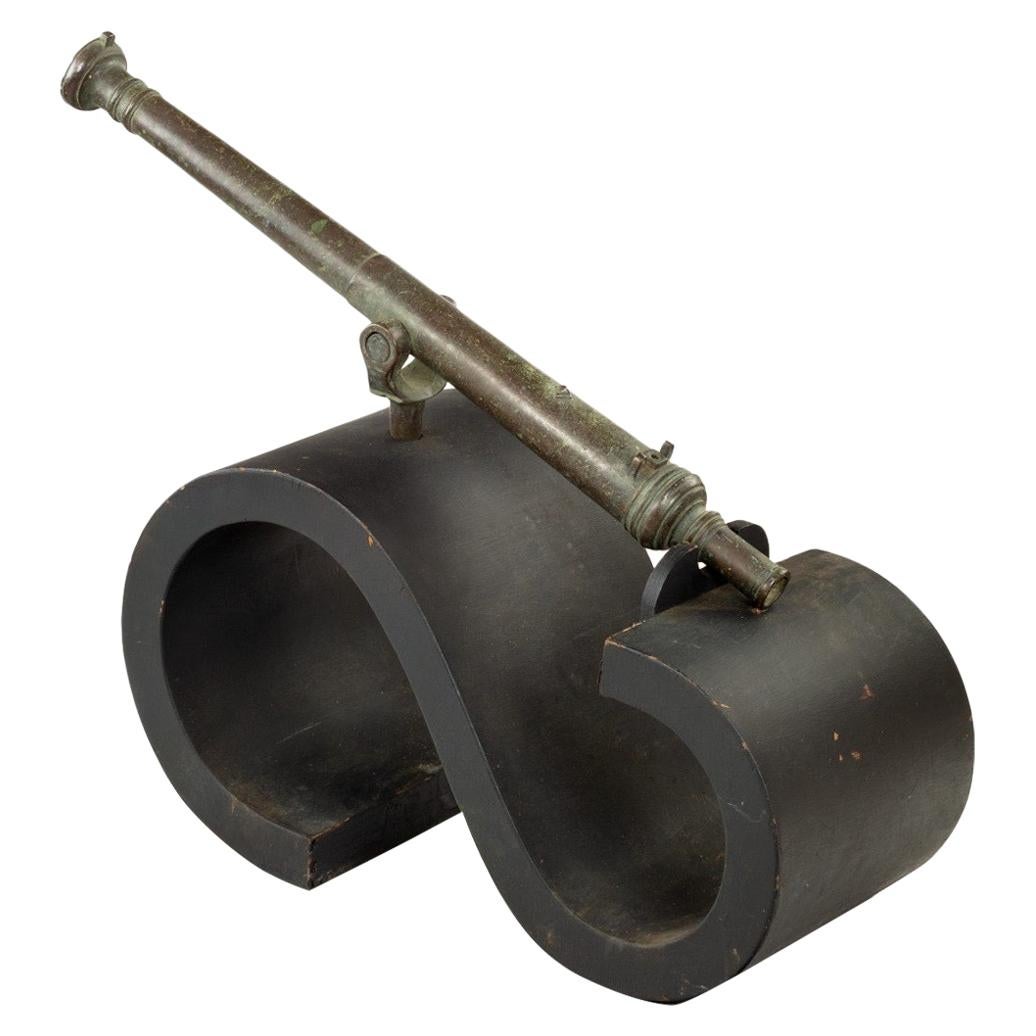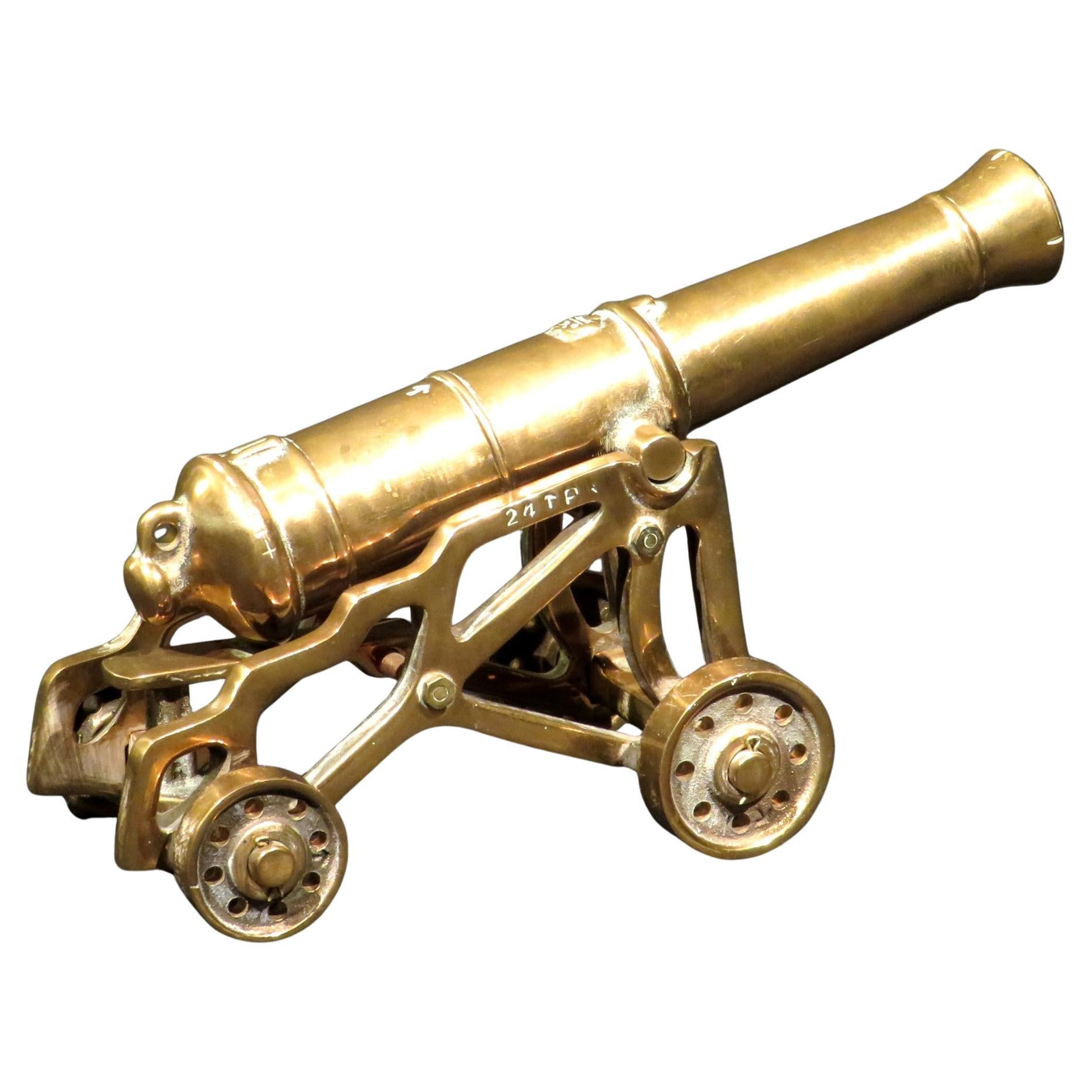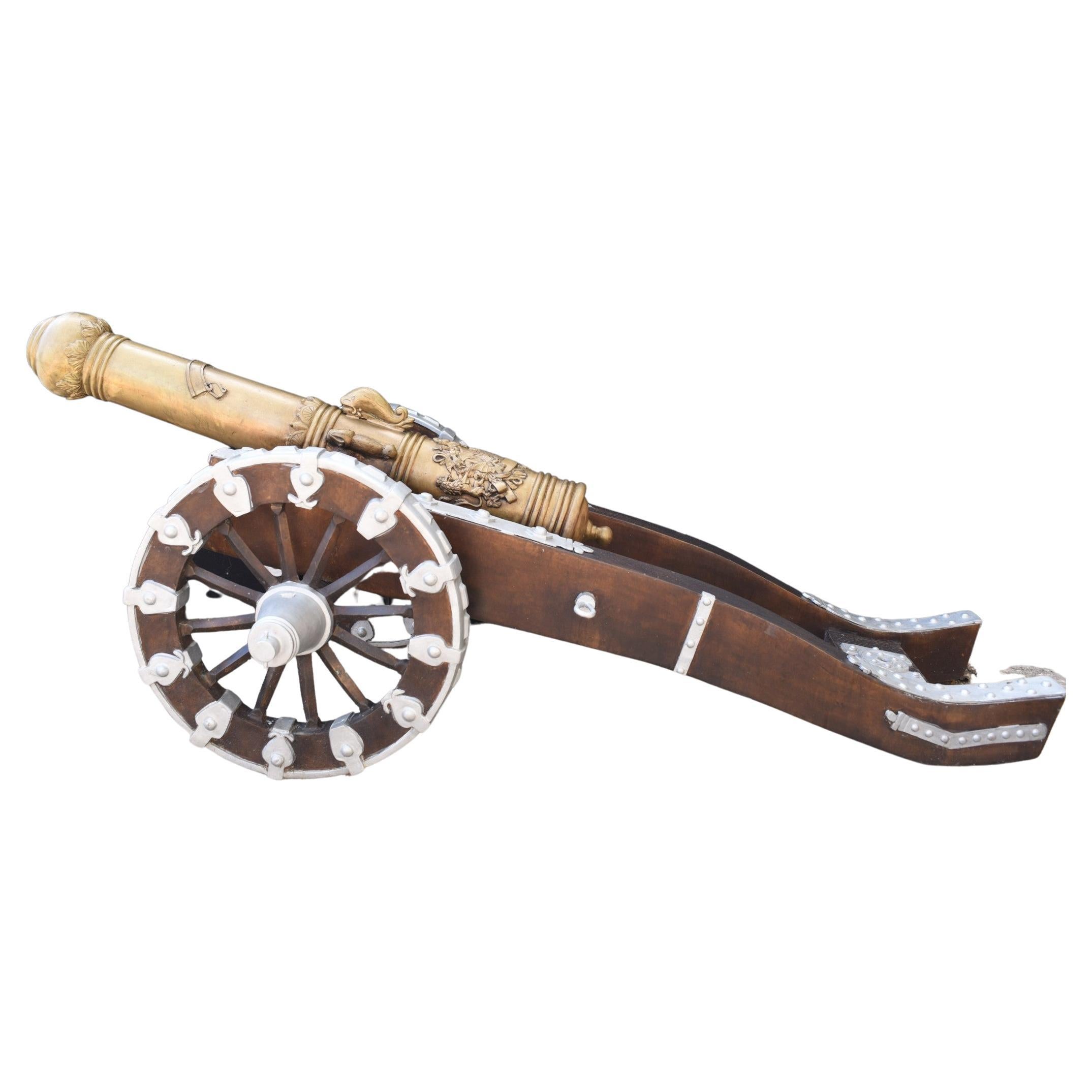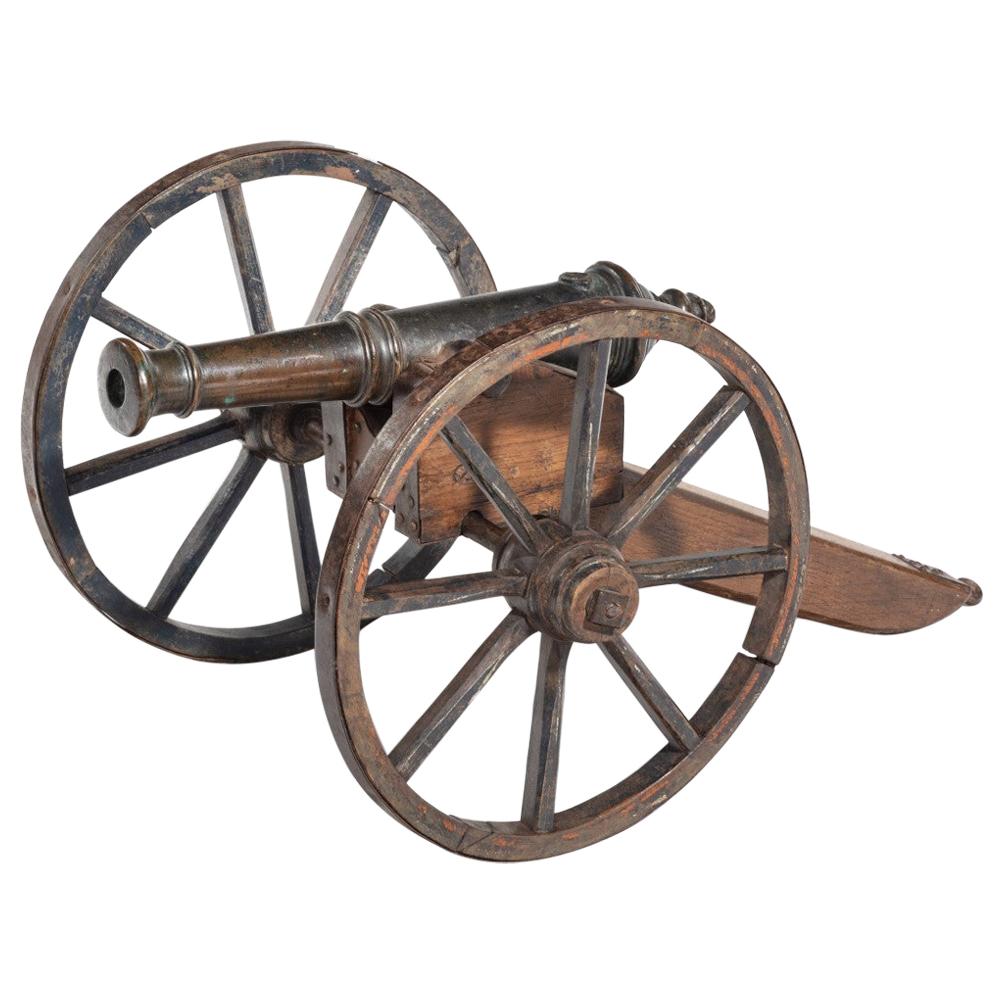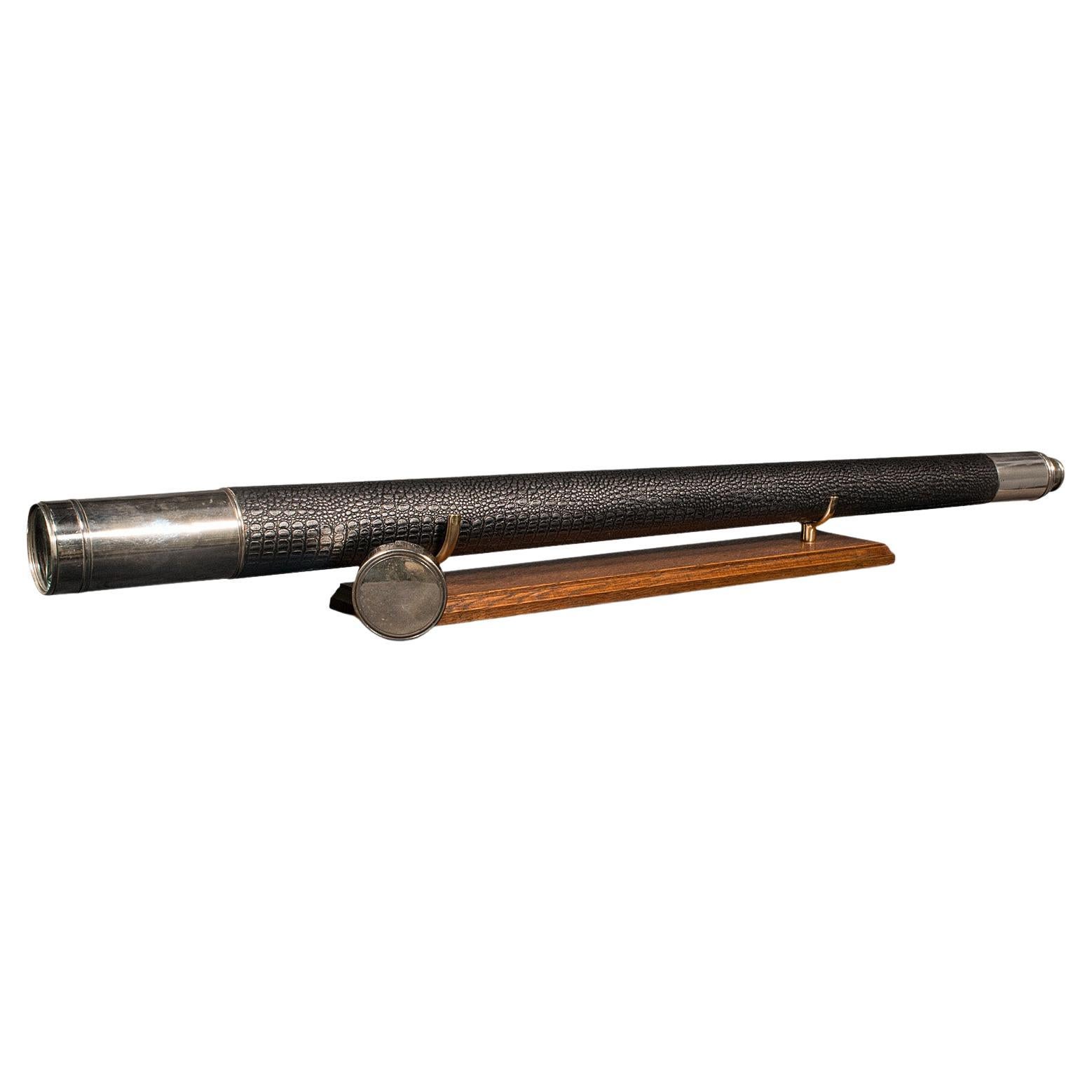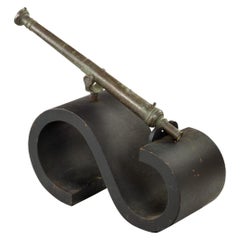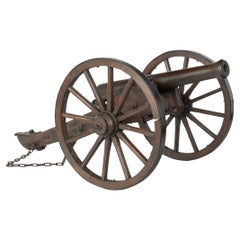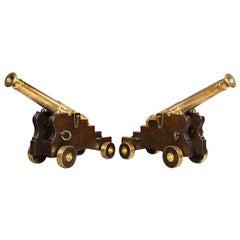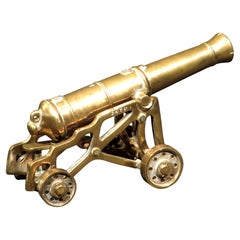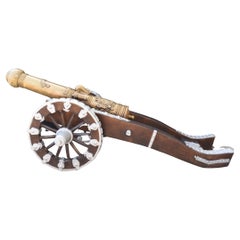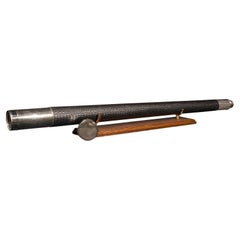Items Similar to A highly important Mughal Indian Cannon captured at Copal Droog, 1858
Want more images or videos?
Request additional images or videos from the seller
1 of 11
A highly important Mughal Indian Cannon captured at Copal Droog, 1858
Price Upon Request
Price Upon Request
Price Upon Request
Price Upon Request
Price Upon Request
Price Upon Request
Price Upon Request
Price Upon Request
Price Upon Request
Price Upon Request
Shipping
Retrieving quote...The 1stDibs Promise:
Authenticity Guarantee,
Money-Back Guarantee,
24-Hour Cancellation
About the Item
A highly important Mughal Indian Cannon captured at Copal Droog, 1858 This remarkable cannon is cast overall with a zig-zag design, often representative of ripples in water. The central cannon shown on the top left of the illuminated manuscript on page 50 show a cannon with a similar ripple pattern in gilt on bronze (described as a “Vandyke pattern” by the 1908 Royal United Service Museum catalogue) with additional floral decoration towards the end of the tapering barrel. The diameter of the bore is 2 ½ inches and is equivalent to ‘less than a 3 pounder’, ibid. The mouth is painted in gilt with numbers H04 and accession number C.20708. Mughal Empire, 1526-1761.
Length: 94in (239cm) max width 16in (41cm) max. diameter approx. 10in (25.5cm)
Provenance: Captured by Major J. E. Hughes and his troops at Copal Droog, 1858
Presented by Major General Donald Macleod to the United Service Institute Museum, Whitehall,
Literature: Journal of the United Service Institute 1864: Vol. 7 appendix p. V
Official Catalogue Royal United Service Museum Whitehall, 1908, p.182, item 2689
Old and New London, 1878, vol. 3. p.325 (in the United Service Museum)
At some 3,500ft in elevation, Copal Droog had long been an important strategic site in India. It was notoriously the site of the execution of several British army officers in 1783 during the Mysore Wars, the Indian forces at this stage being commanded by Tipu Sultan. In May of 1819, the fort was captured by British forces after a long siege and then lost again resulting in another assault in 1858. The United Service Museum 1908 catalogue states that the piece came from “Copiddroog”, something which has led to certain amounts of speculation about the true location of the piece when captured in 1858. An added complication can be seen in The Families in British India Society lists which have 9 different spellings for this one place. The 1819 siege was a protracted affair but the 1858 attack was much more straightforward from the British perspective. The Homeward Mail newspaper reported on 19th July 1858 that the siege had taken no more than three hours of fighting with 100 of the defending forces killed, including the two leaders of the rebellion, and 150 taken prisoner. Only 7 British troops were injured. However, a reference in the Journal of the United Service Institute for 1864 confirms the capture at the siege of the important Copal Droog Hill located to the southwest of Bangalore on the 2nd of June 1858.
Despite the sources mentioned in our literature, attributing this military success at Copal Droog to Major General Macleod, it is clear from contemporary sources that he played little to no part in the operation. He was in charge of the “ceded districts” in India and the battle itself was conducted by a column of troops under Major J. E. Hughes. The crushing of the rebellion led to swift promotions for both Hughes and Macleod, both of whom enjoyed long and successful careers. Macleod was promoted to Lieutenant-Colonel of the Madras Army in 1862 and Hughes became Brevet-Lieutenant Colonel of the Madras Native Infantry in 1959.
- Dimensions:Height: 94.1 in (239 cm)Diameter: 10.04 in (25.5 cm)
- Materials and Techniques:
- Place of Origin:
- Period:
- Date of Manufacture:1526-1761
- Condition:Wear consistent with age and use.
- Seller Location:Lymington, GB
- Reference Number:1stDibs: LU973043505992
About the Seller
5.0
Recognized Seller
These prestigious sellers are industry leaders and represent the highest echelon for item quality and design.
Established in 1982
1stDibs seller since 2013
132 sales on 1stDibs
Typical response time: 2 hours
Associations
LAPADA - The Association of Arts & Antiques Dealers
- ShippingRetrieving quote...Shipping from: Lymington, United Kingdom
- Return Policy
Authenticity Guarantee
In the unlikely event there’s an issue with an item’s authenticity, contact us within 1 year for a full refund. DetailsMoney-Back Guarantee
If your item is not as described, is damaged in transit, or does not arrive, contact us within 7 days for a full refund. Details24-Hour Cancellation
You have a 24-hour grace period in which to reconsider your purchase, with no questions asked.Vetted Professional Sellers
Our world-class sellers must adhere to strict standards for service and quality, maintaining the integrity of our listings.Price-Match Guarantee
If you find that a seller listed the same item for a lower price elsewhere, we’ll match it.Trusted Global Delivery
Our best-in-class carrier network provides specialized shipping options worldwide, including custom delivery.More From This Seller
View AllLate 18th Century Bronze Lantaka Cannon
Located in Lymington, Hampshire
A late 18th century bronze Lantaka cannon, the slightly tapering barrel cast with flanges and set on a hinged pin. With a modern black S-scroll Stand. D...
Category
Antique 1790s Dutch Arms, Armor and Weapons
Materials
Bronze
Mid-Victorian Model of a Field Cannon
Located in Lymington, Hampshire
A mid-Victorian model of a field cannon, the bronze barrel set on an oak carriage with large iron-bound wheels, with traces of the original black, red an...
Category
Antique 1870s English Arms, Armor and Weapons
Materials
Bronze
A late 19th century scale model of field cannon
Located in Lymington, Hampshire
A late 19th century scale model of field cannon, the barrel with a flared muzzle on an oak carriage with twin twelve spoke steel rimmed wheels and steel m...
Category
Antique Late 19th Century European Arms, Armor and Weapons
Materials
Steel
Fine Pair of 19th Century English Barrel Bronze Cannon on Oak Carriages
Located in Lymington, Hampshire
Fine pair of mid-19th century English bronze cannon with tapering 41" barrels and flared muzzles, the top of each breech engraved with the family crest o...
Category
Antique 1850s English Arms, Armor and Weapons
Materials
Bronze
Fine Pair of Bronze Cannon by McAndrew and Woore English, circa 1850
Located in Lymington, Hampshire
A fine pair of bronze cannon by McAndrew and Woore, set on their original brass bound black painted oak carriages with brass spider wheels, also with a p...
Category
Antique 1850s English Arms, Armor and Weapons
Materials
Bronze
Pair of English Bronze Signal Cannon
Located in Lymington, Hampshire
A fine pair of English bronze signal cannon, the tapering 36 inch two stage barrels set upon original mahogany carriages with bronze fittings and ...
Category
Antique 1850s English Arms, Armor and Weapons
Materials
Bronze
$73,747 / set
You May Also Like
A Fine Model of a 19th C. British 24-Pounder Muzzle-Loading Smoothbore Cannon
Located in Ottawa, Ontario
A finely cast model of an early 19th century British 24-pounder smoothbore muzzle-loading artillery cannon, together with its garrison style carriage.
Both cast in heavy gauge 'bell...
Category
Early 20th Century British Victorian Arms, Armor and Weapons
Materials
Bronze
Pair Giant French Bronze Cannons, Military Artillery
Located in Potters Bar, GB
Impressive pair of large French bronze cannons
Great for a garden or business
Of course being bronze these can live outside with no fear of rusting
Viewings available by appointm...
Category
Vintage 1980s Arms, Armor and Weapons
Materials
Bronze
Mid 20th Century Line Throwing Gun
Located in Norwell, MA
Line throwing gun with maker's badge, barrel, and carriage. Entire unit is iron, not bronze. Front level adjusting bar is present. Overall length: 33" W x 12" D x 15" T.
Category
Vintage 1950s North American Arms, Armor and Weapons
Materials
Iron
Antique Telescope, English, Silvered Brass, Dennis of London, Victorian
Located in Hele, Devon, GB
This is a long antique telescope. An English, silvered brass single draw refractor by Dennis of London, dating to the early Victorian period and later, circa 1850.
Perfect for bird watching, landscape appreciation, wildlife, or maritime observation. Equally suitable for observing the night sky.
Superior length telescope with appealing finish and personal inscription
Displaying a desirable aged patina throughout
Silvered brass presents bright, reflective tones
Bright objective with large 55mm diameter — some marks to lens edge
Front element protected by sliding sun shade
Removable dust cover encloses the element when not in use
Primary barrel dressed distinctively in a later, quality faux crocodile cover...
Category
Antique Mid-19th Century British Scientific Instruments
Materials
Brass
Antique Persian Qajar Period Engraved and Inlaid Iron Metal Pen Box or Holder
Located in Hamilton, Ontario
Dating from the Qajar period, this cast iron pen case is highly and intricately engraved with a scroll patterned motif which has been inlaid with gold accents. The fitted top holds f...
Category
Antique 18th Century Indian Other Scholar's Objects
Materials
Gold, Iron
Antique Decorative Cast Iron Cannon Early 20th Century
Located in London, GB
This is a superb antique decorative cast iron signal cannon mounted on a two-wheeled carriage, and dating from Circa 1920.
This well-proportioned and detailed cast iron model of an ...
Category
Early 20th Century Models and Miniatures
Materials
Iron
